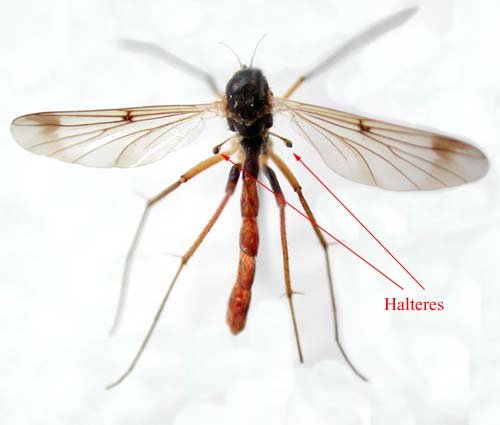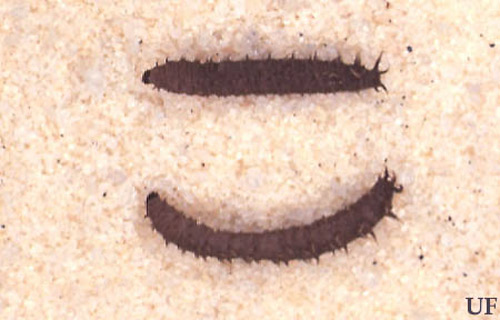|
Species: Plecia
nearctica Hardy, 1940
I named this blog Lovebug because I love bugs. I also have
an early memory of being amazed by a huge cloud of lovebugs
surrounding me in my backyard. Maybe that's where I first
began my fascination with insects. You're probably familiar
with lovebugs if you live in the American Southeast. They’re
the little black and red flies that descend upon the world
and stick to your car. Like me, you might have assumed that
the summer swarms were always a part of the landscape.
Lovebugs are actually native to Mexico and Central America,
and they only made it to the US in the 1920s. That makes
them a very recent invasion, biologically speaking. Their
northward expansion was a natural migration and not the
result of human introduction, intended or accidental. Some
authors still refer to them as "invaders" because of their
relatively new arrival to North America, but they should not
be mistaken for a human-introduced species.

bob in swamp
Lovebugs can certainly be annoying en masse, but I find them
endearing (in fairness I find most bugs endearing). They
aren't very good fliers, especially when coupled. They fly
slowly, they bump into things, and they’re very easy to
catch. They have a hard time walking on surfaces because the
male and female tend to have different ideas about which way
to move. They don't bite or sting, so they can't hurt you at
all. The one big downside is that they will stick to your
car in large numbers and can actually cause damage to the
paint if you don't scrape them off quickly. So if you're new
to the South, watch out.

MyFWC Florida Fish and Wildlife
Origin
There is apparently a persistent and long-standing rumor
that lovebugs were "created" by the University of Florida to
eat mosquitos. I can’t help but love this idea that some mad
scientists at my alma mater fabricated an entire species
from nothing and released it unto the world, to wreak havoc
on highways. Unfortunately, it’s impossible. Not to mention
the fact that a lovebug doesn’t have the mouthparts to eat
another insect, much less a mosquito nearly its own size.
Sadly, it seems lovebugs evolved the good old fashioned way.
The genus Plecia has around 75 extant species, and 113
extinct ones. That means there's a long and robust fossil
record to support our lovebug's evolution. Most of the
living species (that I could find pictures of) look very
similar to each other, with the characteristic black body
and red thorax.
Reproductive Strategy
Lovebugs get their common name from their, uh, active love
life. Insect life cycles are usually brief: the egg hatches,
the larva eats enough to pupate, the adult emerges from the
pupa, the adult finds a mate, the next generation is
produced. Lovebugs only live as adults for less than a week,
so mating is the only priority. During mating, the male and
female flies become attached at the abdomen. It takes about
12 hours to complete the sperm transfer, but the bugs will
stay attached for up to 2 days. Why? It's an adaptation to
increase the male's chances of producing offspring. If the
male stays attached, he prevents any other males from mating
with his female. This way the female's entire clutch of eggs
will be fathered by him, instead of split between different
males.
Now, the downside to this strategy is that the male does not
get to mate with other females, which would be another way
of increasing his chances of having offspring. So we have a
classic evolutionary trade off--mate with only one female
but ensure reproduction, or mate with many females with no
guarantees. This is the same tradeoff seen in other
monogamous vs polygamous animals, so I would consider
lovebugs a form of insect monogamy. Both strategies have
been successful on Earth, but a surprising number of
creatures have evolved to be monogamous or serially
monogamous (only one partner until the partner dies).
Lovebugs may be the best example of extended sexual
coupling, but they are not the only insects that do this.
Even other animals like dogs and wolves stay locked together
after mating, although it lasts minutes instead of days.
Caption: Lovebugs showing characteristic
coupling. The smaller one with the larger eyes
is the male.
The male lovebug will actually die attached to the female,
and she has to drag his corpse around while she finds a good
spot to lay her eggs--up to 350 of them. Multiply that by
the number of females that survive to lay eggs, and that's
an awful lot of bugs. Lovebugs are a great example of R
strategists. R and K selection theory is the idea that there
is a trade-off between number of offspring and likelihood of
survival. R-selected species make many many babies, but most
will die before adulthood (ex: frogs). K-selected species
only produce a few offspring, but each one is cared for to
maximize its chances for survival (ex: humans and other
apes). Like most theories, it's a bit of an
oversimplification and can't be applied easily to all
organisms.
Lovebug populations explode in April/May and
August/September to coincide with spring and fall rains. The
swarms last about a month each time. The flies are still
around the rest of the year, just in much lower numbers.
Classification
Lovebugs are true flies in the order Diptera. They may not
look like the average fly that comes to mind, which is
probably a house fly (Muscidae) or similar family. Luckily,
flies are easily distinguished from other orders because
they only have 2 wings (Di-ptera, two-wing). Other flying
insects (don't even start with Strepsiptera, I'll get to
that someday) have 4 wings, or 2 pairs. In flies, the
hindwings haven't disappeared completely; they’ve been
modified into halteres, which function as gyroscopes to help
the insects fly better. A haltere looks like a knob on a
stick. Here are some pictures:
  Emily
Coyte Emily
Coyte
@bisc317
If you see halteres, it's a fly. All flies have halteres.
They're very easy to see on craneflies (also Nematocera)
(see photos). Lovebugs have them too, but you’d have to lift
the black forewings away to find them.
Flies also commonly have big round eyes that touch at the
top of the head, and short stubby antennae. Lovebugs fit
this picture.
The beginner entomologist is in luck because lovebugs are
very easy to identify and there are only two species
occurring in North America, so a species ID is possible.
Many insect groups aren’t so simple, and it can be next to
impossible to identify a specimen down to the exact species.
People devote their entire careers to sorting out things
like that.
Lovebugs are in the family Bibionidae, the march flies.
Bibionidae is in the superfamily Nematocera, which is basal
to Brachycera. This just means that taxonomists split flies
into 2 huge groups, and Nematocera evolved first (we know
from morphology and DNA). Nematocera is characterized by
delicate-looking flies with long, thin legs. Bibionidae is
something of an exception to that rule. I would not consider
the family particularly delicate.
  Mardon Mardon
Bibio sp.
BugLady
There is actually a US native lovebug in the same genus.
Plecia americana is a closely related fly that looks almost
identical to P. nearctica. You can tell them apart by
looking at the thorax- P. nearctica is only red on the top
of the thorax (dorsal side), but P. americana is red all
around the thorax, on the dorsal and ventral sides.
P. americana is much more rarely seen. They don't produce
massive swarms over highways the way lovebugs do, instead
keeping to wooded areas. They emerge in the spring only,
lacking the additional fall flight that lovebugs have. P.
americana was also described by Hardy in 1940. Unlike P.
nearctica, P. americana is native to North America. It seems
to occur in a belt of states on the Eastern side of the
country, North and South Carolina west to Missouri.
Ecology
So why should you love lovebugs? Like all organisms, they
occupy an important ecological niche that other organisms
have come to rely on. Adult lovebugs feed on nectar, helping
to pollinate wildflowers such as goldenrod and clover. The
larvae play an important role in breaking down decomposing
matter. Fungi, bacteria, and earthworms are the most well
known decomposers, but many insect species also belong to
this group (termites are an important example). Without
decomposers, the earth would be overrun with dead material,
and nutrients could never be recycled back into the food
chain.
 James
Castner James
Castner
Lovebug larvae are cryptic, caterpillar-like maggots that
live in the top layer of soil. They are eaten by birds,
centipedes, and insects such as earwigs and beetles. I would
guess other small animals, such as frogs, probably prey on
lovebugs as well, but there is limited information on the
subject.
You'd expect that a giant swarm of clumsy fliers would be
easy prey, but adult lovebugs have surprisingly few
predators. Wikipedia says nobody likes to eat the adults
because of the "acidic taste," but I can't find good
evidence to support that. There has been speculation that
lovebugs exhibit aposematic coloration--bold colors that
warn predators of distasteful/toxic compounds. A 2009 study
found that lovebugs were not toxic. However, that study had
a very limited scope. It's possible that there are so many
black/red distasteful insects (particularly in Florida) that
predators have learned to avoid all black and red things,
and thus leave the lovebugs alone. The lovebug's lack of
predators remains something of a mystery.
It seems the lovebug is here to stay in the Southeast. It's
possible its range will continue to expand northward as
global temperatures increase. They may be hard on your car,
but they're good for the soil, and they don't seem to have
much impact on local wildlife communities. Swarm numbers
have gone down as natural population controls like parasitic
fungi catch up to the lovebugs. So even though they have few
predators, they aren't running around unchecked like many
invasive species.
Lovebugs get plenty of hate, so the next time you see one
(or a thousand), show them a little love.
|